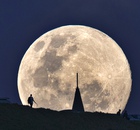 |
| Gunshot to the face or head right through the windshield? (Sascha Burkard/iStockphoto) |
The Violence Within Us
Violence and brutality are grim realities of life. In one hour, four TED speakers explore the sinister side of our dim human nature -- and ask whether we're all capable of violence.
"Pray to the Moon when it's round. Death with you shall then abound..." sings Slayer (from "Hell Awaits"), one of the most popular bands for U.S. militants, along with all things porn, songs serial killers might whistle while engaged in their doings.
Violence and brutality are grim realities of life. In one hour, four TED speakers explore the sinister side of our dim human nature -- and ask whether we're all capable of violence.
"Pray to the Moon when it's round. Death with you shall then abound..." sings Slayer (from "Hell Awaits"), one of the most popular bands for U.S. militants, along with all things porn, songs serial killers might whistle while engaged in their doings.
(Slayer) See Minute 4:15. Slayer and rap music were PMRC targets
U.S. tanks come equipped with CD players and premium music systems. Why? American soliders like to enjoy some music to kill by. "Driven by the instinct of centuries of horror/ Implanted along the brain of the sickening parasite/ Linked together by one trait/ The hell-filled need to kill, kill, kill, kill, KILL" (Slayer, "At Dawn They Sleep"). But the No. 1 song on the military hit parade is "Bodies" by Drowning Pool: "Let the bodies hit the floor"! What is more "evil" (Pali papa) than industrial-scale killing?
 |
| Psychology Prof. Phil Zimbardo on his Stanford Prison Experiment |
 |
| AUDIO: What does the [brain] of a killer look like? (Jim Fallon) |
TED Censorship?
(RT, June 2014) Graham Hancock breaks the set on TED CENSORSHIP, Lost Civilizations, and War on Consciousness: Abby Martin interviews author Graham Hancock about the mysteries of ancient civilizations, hidden societies of the past, and censorship by TED Talks and the difficulty of getting new ideas accepted by mainstream archaeologists and historians.
The Super Full Moon Tonight
 |
| Moon over Auckland (TG) |
Supermoon lights up skies around the world – in pictures. The perigee Moon, or Supermoon, rises over Mount Eden in Auckland, New Zealand, on Sunday morning. A dramatic Supermoon is set to accompany this year's Perseid meteor shower, one of the most anticipated events on the skywatcher's calendar. Given a dark, clear sky in a normal year, it is common to see more than 100 of the meteors an hour during the second week in August. But this year the Perseids have a bright shining rival. On Sunday, two days before the meteor shower reaches its peak, the Moon will become full. Coincidentally, it will also have reached the point in its orbit that is closest to the Earth, known as perigee. The Supermoon will be up to 14% bigger and 30% brighter than other full moons during the year. On one level, this is bad news, according to Dr. Bill Cooke from NASA's meteoroid environment office. "Lunar glare wipes out the black, velvety backdrop required to see faint meteors, and sharply reduces counts." More


No comments:
Post a Comment